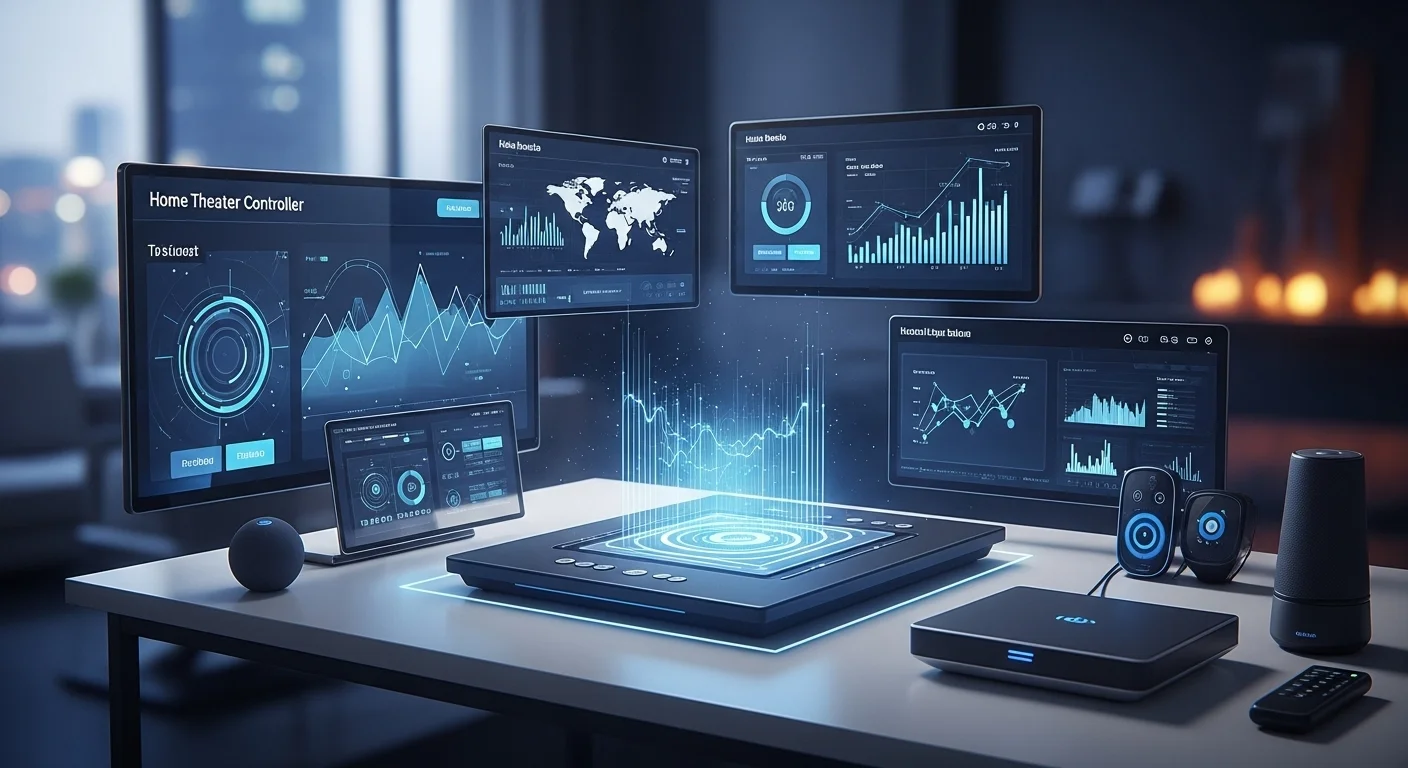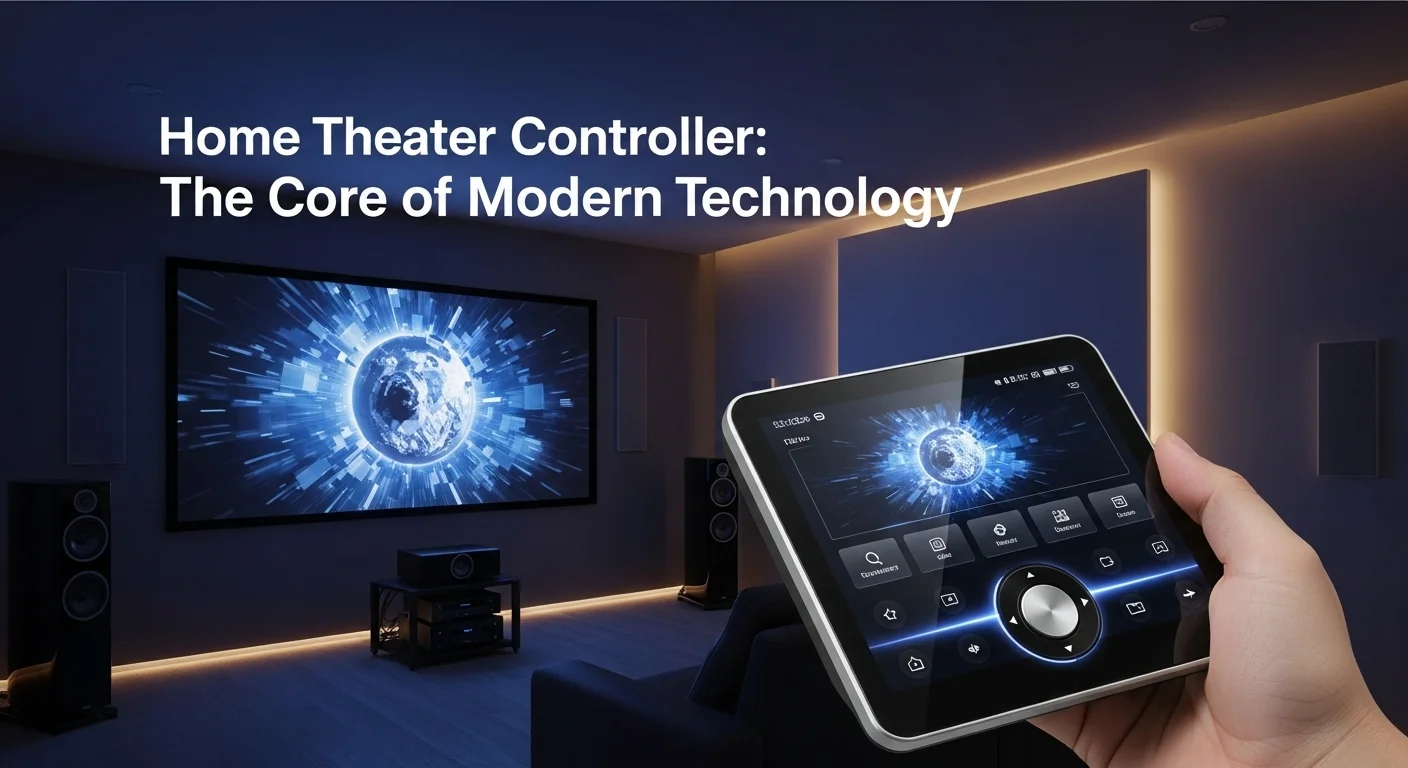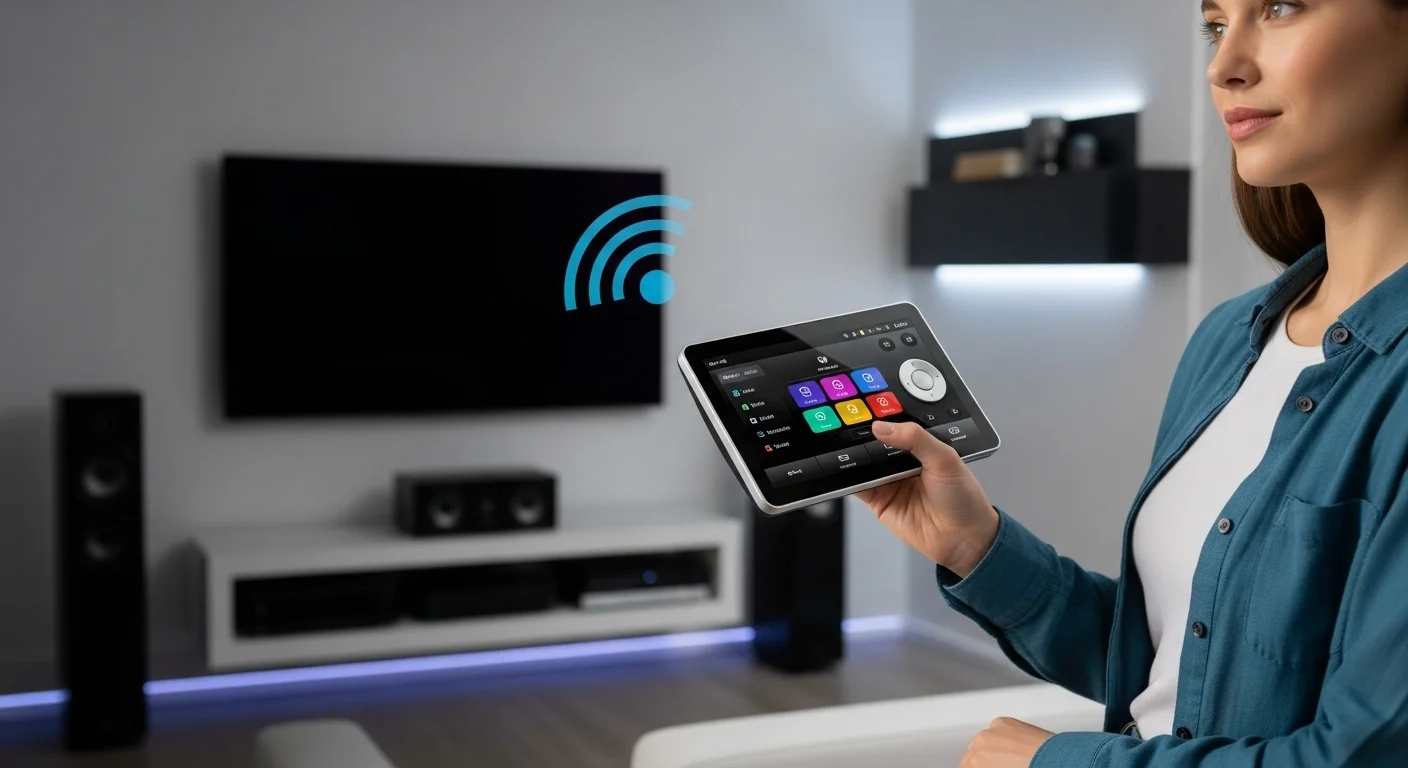Your Home's Command Center: A Personal Guide to Home Theater Controllers

Executive Summary
In my years of designing smart homes, I've seen the same thing over and over: a coffee table littered with remotes and a frustrated family who just wants to watch a movie. The solution isn't another universal remote; it's a true command center. The home theater controller has evolved into the brain of the modern home, seamlessly connecting your entertainment, lighting, and so much more. This article is my personal guide for tech lovers and businesses alike. I'll walk you through what these systems really are, how they work their magic with lighting, and how to pick the best one for you, whether it's a high-end system like Control4 or a DIY project. We'll explore how this single piece of tech can simplify your life, save energy, and create experiences that feel like magic.
Table of Contents
Table of Contents
- What is a Home Theater Controller and Why Does It Matter?
- The Evolution from Universal Remote to Automation Hub
- Core Components and How They Work Together
- The Magic of Integrated Home Theater Lighting Control
- Beyond the Living Room: Business Applications
- The Real-World Benefits for You and Your Business
What is a Home Theater Controller and Why Does It Matter?
In a world where almost every device is 'smart,' the real challenge is making them work together. That's where a home theater controller comes in. Forget what you know about old universal remotes. This is the central nervous system for your home or office. At its heart, a controller is a device or app that brings all your tech—audio, video, lighting, climate—under one simple, intuitive interface. I've seen firsthand how this technology transforms a space. Its true importance lies in its ability to take a complex mess of devices and make them feel like a single, cohesive system. It's not just about convenience; it's about creating an environment that responds to you, effortlessly.
The Evolution from Universal Remote to Automation Hub
I remember the early days, spending hours programming universal remotes with long code lists, hoping to eliminate a few remotes from the coffee table. Those devices were a good start, but they were limited. The real game-changer was network connectivity. Today's home theater control systems are true automation hubs. They speak multiple languages—IP, Zigbee, Z-Wave, and even old-school IR—to communicate with everything from your 4K projector to your smart blinds and thermostat. This means your controller isn't just sending a signal; it's having a conversation with your devices. It's a powerful home theater automation controller that can run entire 'scenes.' I've programmed countless 'Movie Night' scenes where one button press dims the lights, closes the shades, fires up the projector, and starts the movie. That's the leap from simple control to true automation, and it's what makes this technology so vital today.
Core Components and How They Work Together
So, what's under the hood? A typical system has three main parts: the processor (the brain), the user interface (your connection to the system), and the communication hardware. The processor is where all the programming and automation logic lives. In robust systems like a Control4 home theater controller, these processors are powerful enough to manage hundreds of devices in a large home or commercial building. The user interface is what you see and touch. It could be a sleek touchscreen, a handheld remote with a screen, or an app on your phone. From my experience, the best home theater control system is the one with an interface that feels natural and easy for everyone to use. Finally, the hardware bridges the gap to your gear. It might use tiny IR emitters for older devices, serial ports for rock-solid communication with high-end gear, or your home network for IP control, which is the gold standard for modern electronics. This flexible architecture means the system is both reliable and ready for whatever new tech comes next.
The Magic of Integrated Home Theater Lighting Control
If there's one feature that always wows my clients, it's integrated home theater lighting control. This is so much more than just dimming the lights. It's about crafting the perfect atmosphere. Good lighting can make your screen's picture pop, reduce eye strain, and completely immerse you in the film. Imagine pressing 'Play,' and your main lights fade to a soft 10% glow while subtle pathway lights stay on. When you hit 'Pause' for snacks, the lights come up to half-brightness automatically. That's the seamless experience a great home theater automation controller provides. Beyond the 'wow' factor, it's also smart. By using only the light you need, when you need it, these systems can make a real dent in your energy bill, especially when paired with automated shades to control natural light.
Beyond the Living Room: Business Applications
This same powerful technology is a huge asset in the business world. I've installed systems in boardrooms, restaurants, and hotels, and the impact is always immediate. In a conference room, a single tap can drop the screen, turn on the projector, dim the lights, and start the video call. It eliminates the all-too-common technical fumbling that kills the momentum of a meeting. In a restaurant, a manager can adjust the music and lighting for different dining zones from one tablet, ensuring the ambiance is always perfect. For premium hotels, giving guests control over their room's entertainment, lighting, and climate from a single interface is a powerful statement of luxury and modern convenience. The reliability of professional systems like the Control4 home theater controller makes them a perfect fit for these commercial settings where things simply have to work, every time. It’s an investment in efficiency, customer experience, and a polished, professional image.
The Real-World Benefits for You and Your Business
For the home tech enthusiast, a controller is the key to unlocking the ultimate smart home. It's about having total, personalized control over your environment and making all your gadgets work in harmony. For a business, the benefits are clear and measurable. It boosts productivity by simplifying tasks, enhances the customer experience, and delivers real cost savings through smart energy management. Centralized control also makes maintenance and troubleshooting much simpler. Whether for your living room or your boardroom, a well-implemented home theater automation controller is a fundamental upgrade that makes technology work for you, not the other way around.

Complete Guide to Home Theater Controllers for Home and Business
Diving into the world of home theater controllers can feel overwhelming. There's a lot of jargon and so many options. My goal here is to cut through the noise and give you a clear roadmap. We'll look at the tech that makes it all work, compare the DIY route against a professional installation, and even peek into the future with AI. Whether you're a hands-on enthusiast building your dream cinema or a business owner looking for a competitive edge, understanding the core concepts of home theater control systems will help you find the best home theater control system for your world.
Technical Deep Dive: How Your Controller Actually Talks to Your Gear
A great home theater automation controller is like a master diplomat, fluent in many languages. Here are the main ones it uses to command your devices:
Infrared (IR): This is the classic language of remote controls. The controller sends a beam of light, just like your TV remote. It's a one-way street—the controller shouts a command but doesn't know if it was heard. We manage this with small 'emitters' stuck directly onto a device's IR sensor.
RS-232 (Serial): Think of this as a private, wired conversation. It's a two-way link, so the controller can send a command and get a status update back, like confirming if the projector is on or what the current volume is. This feedback is essential for a truly smart system and is a feature of most high-quality AV gear.
IP (Internet Protocol): This is the modern, network-based language. Using your home's Ethernet or Wi-Fi, IP control is fast, powerful, and offers rich, two-way communication. It's how your controller can display your entire movie library from a server. It also means having a solid, secure network is more important than ever.
Zigbee & Z-Wave: These are low-power wireless languages perfect for smart home devices that aren't part of your theater—things like light switches, door locks, and thermostats. A controller with these radios, like a Control4 home theater controller, can become the hub for your entire smart home, not just the media room.
Comparing the Contenders: DIY vs. Professional Systems
This is one of the biggest decisions you'll make. I've seen both paths lead to success, but they are very different journeys.
DIY Solutions: Options like Home Assistant or products from brands like Broadlink are fantastic for the tech-savvy person who loves to tinker. You'll save money upfront and have immense flexibility. I have a lot of respect for what people accomplish with these systems. However, be prepared to be your own tech support. Getting different brands to play nicely can be a real headache, and the responsibility for updates and maintenance falls squarely on you.
Professional Systems: Companies like Control4, Savant, and Crestron are the gold standard. You're not just buying a product; you're hiring an expert—an integrator like me—to design, install, program, and support the entire system. I've helped clients who first tried the DIY route and grew tired of the constant troubleshooting. With a professional system, you get a polished, reliable solution that's easy for the whole family or staff to use. While a Control4 home theater controller system is a bigger investment, you're paying for peace of mind and a system that just works. For many, this is the definition of the best home theater control system.
The Role of AI and Cloud Computing in Modern Control
The next chapter in home control is already being written by AI and the cloud. These systems are getting smarter. AI can learn your habits—like knowing you prefer lower volume for the morning news and full surround sound for movie night—and adjust things for you automatically. Voice control through cloud platforms like Alexa and Google Assistant has already revolutionized how we interact with our homes. Saying 'Alexa, turn on Movie Night' and watching the magic happen is an experience that never gets old. The cloud also allows professionals like me to remotely diagnose and often fix issues without ever having to visit your home, and it ensures your system's programming is safely backed up. We're moving toward a future where your home won't just respond to your commands, but will anticipate your needs, perhaps adjusting the home theater lighting control based on the time of day or even the type of movie you're watching.
Business Techniques and Resources for Integrators
For my fellow professionals in the custom installation field, our success is built on more than technical skill. It's about delivering a human-centric solution.
Consultation: It all starts with listening. I never start by talking about products. I ask about lifestyle, family, and frustrations. What problem are we trying to solve? Who needs to use this system? A great design is born from understanding the client, not from a spec sheet.
System Design: My philosophy is to build systems that are reliable, intuitive, and scalable. This means a rock-solid network, components chosen for longevity, and an interface so simple a guest can use it without instructions. When designing home theater lighting control, for example, I create scenes for every activity: 'Movie,' 'Sports,' 'Cleaning,' 'Relax.'
Programming and Installation: This is our craft. A clean installation with meticulous wiring is a point of pride. The programming is where we bring the client's vision to life, creating automation that feels both powerful and personal.
Resources: Continuous learning is key. Organizations like CEDIA are indispensable for training and certification. Manufacturer portals, like those from Control4, provide deep knowledge and support. Keeping up with trends in AI and cybersecurity isn't just a good idea; it's our responsibility to our clients.
Ultimately, whether you're a DIYer or you hire a pro, the goal is the same: to make technology enhance your life. By understanding these core ideas, you're already on your way to making a smart decision. Investing in a system like a Control4 home theater controller is about investing in simplicity, enjoyment, and efficiency for years to come.

Tips and Strategies to Get the Most from Your Home Theater Controller
Getting a powerful home theater controller installed is just the beginning. The real fun starts when you make it truly your own. I want to share some practical tips and strategies I've learned over the years to help you transform your system from a simple remote into the heart of your smart home or business. We'll cover how to choose wisely, program like a pro, and keep your connected home safe. My goal is to help you create what you'll truly feel is the best home theater control system for your life.
Best Practices for Selecting Your Home Theater Controller
Choosing the right foundation is everything. Here’s what I advise my clients to think about before they spend a dime.
1. Think Long-Term: Make a list of everything you want to control right now. Then make another list of what you might want to control in five years. Do you dream of adding home theater lighting control? What about smart shades, security cameras, or whole-home audio? Starting with a scalable system, like a Control4 home theater controller, means you won't have to start over when you're ready to expand.
2. Be Realistic About Your Budget: These systems can range from a few hundred dollars for a basic hub to tens of thousands for a fully integrated professional installation. When budgeting, remember to include the cost of the smart devices themselves (like dimmers and locks) and, if you go that route, the invaluable expertise of a professional installer. I've often seen that investing in professional programming saves a lot of headaches and leads to a system you'll actually use and love.
3. The Interface is Everything: You'll be using this interface every single day. It has to be fast, intuitive, and easy for everyone—kids, guests, and non-techy spouses included. I always insist my clients get a hands-on demo. How does the app feel? Is the remote comfortable? A clunky interface will turn the most powerful system into a source of frustration.
4. Your Network is Non-Negotiable: A modern home theater automation controller lives on your network. A spotty, unreliable network will lead to a spotty, unreliable system. If you can, run a physical Ethernet cable to your most important devices. If you're relying on Wi-Fi, invest in a high-quality system designed to handle the demands of streaming and dozens of smart devices.
Optimizing Your Experience with Smart Programming and Scenes
This is where you unlock the system's true potential. Scenes are chains of commands that happen with one touch.
1. Think in Activities, Not Devices: Don't think 'Turn on the TV.' Think 'Watch a Movie.' My favorite 'Movie Night' scene dims the lights to a cozy 5%, closes the blackout shades, turns on the receiver and projector to the right inputs, and even nudges the thermostat down a degree. Create other scenes like 'Watch Sports' (with brighter lights) or 'Listen to Music' (which keeps the TV off).
2. Use Your Voice: Connecting your system to Alexa or Google Assistant is a must. It feels like living in the future. Program simple phrases to trigger your scenes. 'Alexa, I'm home' can become a 'Welcome' scene that turns on lights, starts a playlist, and adjusts the temperature. It's the ultimate in convenience.
3. Let Your Home Work for You: Use schedules and sensors to automate things. Program your home theater lighting control to change with the time of day. Use motion sensors to save energy by turning lights off in empty rooms. Have your smart shades close automatically during the sunniest part of the day to help your A/C.
4. Personalize It: The best home theater control system adapts to its users. In a family home, I might create a 'Homework' scene for the kids that turns off the game console and brings up task lighting. In an office, you can set different permission levels for staff versus management, ensuring people only have access to the controls they need.
Cybersecurity for Your Connected Theater
As your controller becomes the digital key to your home, keeping it secure is paramount. You wouldn't leave your front door unlocked, so don't leave your digital door wide open either.
1. Lock Down Your Wi-Fi Router: This is your front line. Immediately change the default admin password. Use strong WPA2 or WPA3 encryption. Turn off any remote access features you don't absolutely need.
2. Use Strong, Unique Passwords: I can't stress this enough. Every single account and device connected to your system needs its own strong, unique password. A password manager is your best friend here.
3. Create a Guest Network: Your router can likely create a separate Wi-Fi network for guests. I recommend putting all your smart home 'things' on this separate network. This isolates them from your main network where your computers and personal files live. If one device gets compromised, the damage is contained.
4. Keep Everything Updated: Manufacturers release updates to fix security holes. Enable automatic updates on your controller, router, and all your smart gadgets. If you have a professionally installed system like Control4, your integrator often manages these updates for you, which is a huge benefit.
5. Trust Reputable Brands: Stick with well-known brands that have a good reputation for providing ongoing security support for their products.
By following these strategies, you'll ensure your system is not just powerful but also a secure and reliable part of your life for years to come. For those interested in the broader impact of technology on business and innovation, I often recommend the Harvard Business Review's Technology section as a great resource for high-level thinking. Embrace these principles, and you'll truly master your home's technology.
Expert Reviews & Testimonials
Sarah Johnson, Business Owner ⭐⭐⭐⭐
As a small business owner, I found this guide on controllers very insightful. I wish it had a few more case studies on how restaurants or small offices can use this tech on a budget, but the foundation is solid.
Mike Chen, IT Consultant ⭐⭐⭐⭐
Great overview of home theater controllers. As an IT guy, I appreciated the breakdown of protocols like RS-232 vs. IP. A few of the concepts were a bit high-level, but it definitely helped me advise a client.
Emma Davis, Tech Expert ⭐⭐⭐⭐⭐
Fantastic article! I'm specializing in home automation, and this was one of the clearest, most comprehensive write-ups I've seen. It perfectly explains why a professional system is often worth the investment. A must-read.



